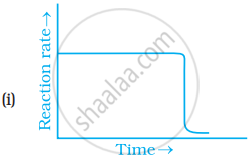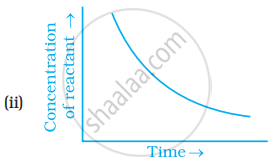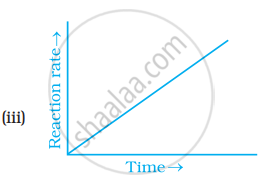Advertisements
Advertisements
प्रश्न
At high pressure the following reaction is zero order.
\[\ce{2NH3(g) ->[1130 K][Platinum catalyst] N2(g) + 3H2(g)}\]
Which of the following options are correct for this reaction?
(i) Rate of reaction = Rate constant.
(ii) Rate of the reaction depends on concentration of ammonia.
(iii) Rate of decomposition of ammonia will remain constant until ammonia disappears completely.
(iv) Further increase in pressure will change the rate of reaction.
उत्तर
(i) Rate of reaction = Rate constant.
(iii) Rate of decomposition of ammonia will remain constant until ammonia disappears completely.
(iv) Further increase in pressure will change the rate of reaction.
Explanation:
The pressure in this reaction is extremely high and it becomes independent of the ammonia concentration. The metal surface becomes saturated with gas molecules when the rate of reaction = Rate constant. The rate of a zero-order reaction is independent of the concentration of reactants in the reaction.
APPEARS IN
संबंधित प्रश्न
The reaction between A and B is first order with respect to A and zero order with respect to B. Fill in the blanks in the following table:
| Experiment | A/mol L−1 | B/mol L−1 | Initial rate/mol L−1 min−1 |
| I | 0.1 | 0.1 | 2.0 × 10−2 |
| II | ______ | 0.2 | 4.0 × 10−2 |
| III | 0.4 | 0.4 | ______ |
| IV | ______ | 0.2 | 2.0 × 10−2 |
The decomposition of NH3 on a platinum surface is a zero-order reaction. If the rate constant (k) is 4 x 10-3 ms-1, how long will it take to reduce the initial concentration of NH3 from 0.1 M to 0.064 M?
Derive integrated rate law for a zero-order reaction \[\ce{A -> Product}\].
For which of the following reaction the units of rate constant and rate of the reaction are same?
Which of the following graphs is correct for a zero order reaction?




Derive an expression to calculate time required for completion of zero order reaction.
Consider the following statement:-
(i) Increase in concentration of reactant increases the rate of a zero-order reaction.
(ii) Rate constant k is equal to collision frequency A if Ea = 0
(iii) Rate constant k is equal to collision frequency A if Ea = 0
(iv) In k vs t is a straight line
(v) In k vs 1/T is a straight line
Which of the above statement is correct?
The slope in the plot of [R] Vs. time for a zero-order reaction is ______.
Assertion (A): For a zero-order reaction, the unit of rate constant and rate of reaction are same.
Reason (R): Rate of reaction for zero order reaction is independent of concentration of reactant.
If unit of rate constant is mol dm−3s−1, the order of reaction would be ______.
